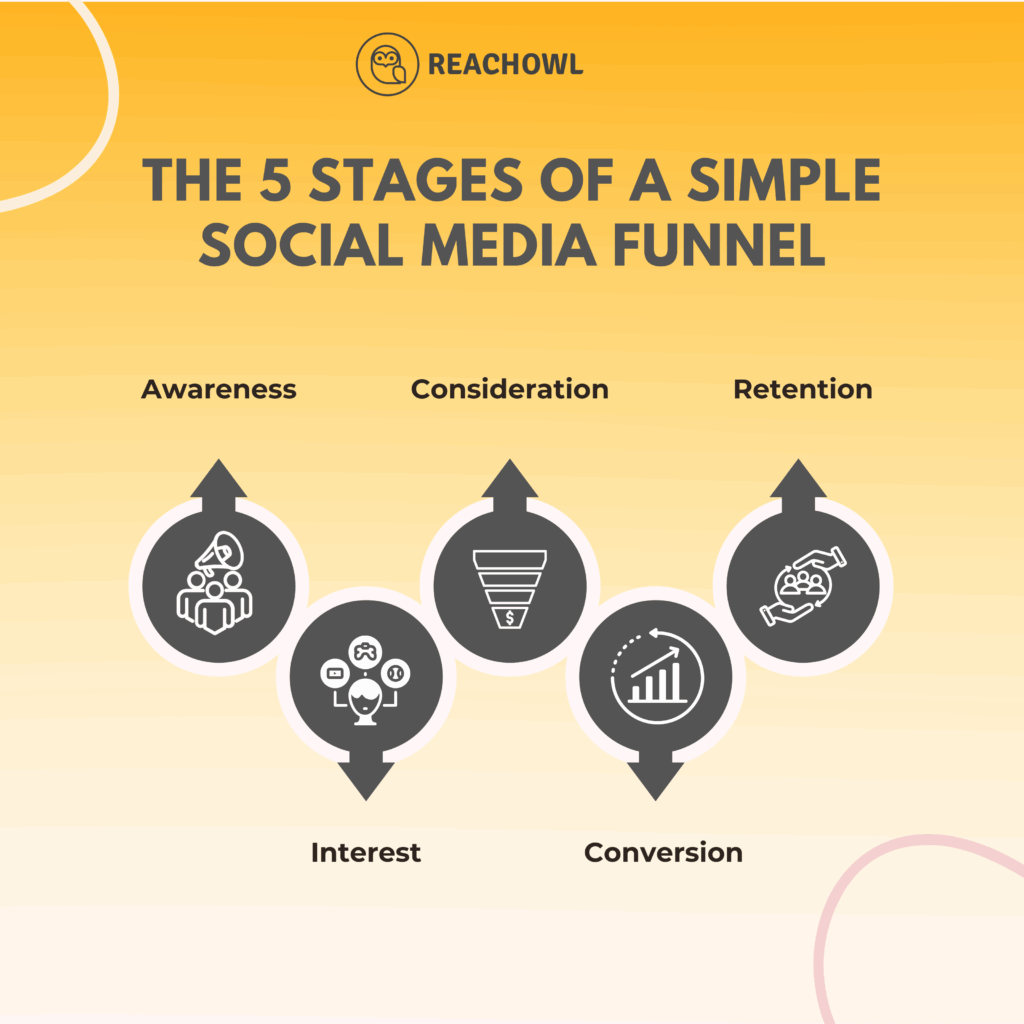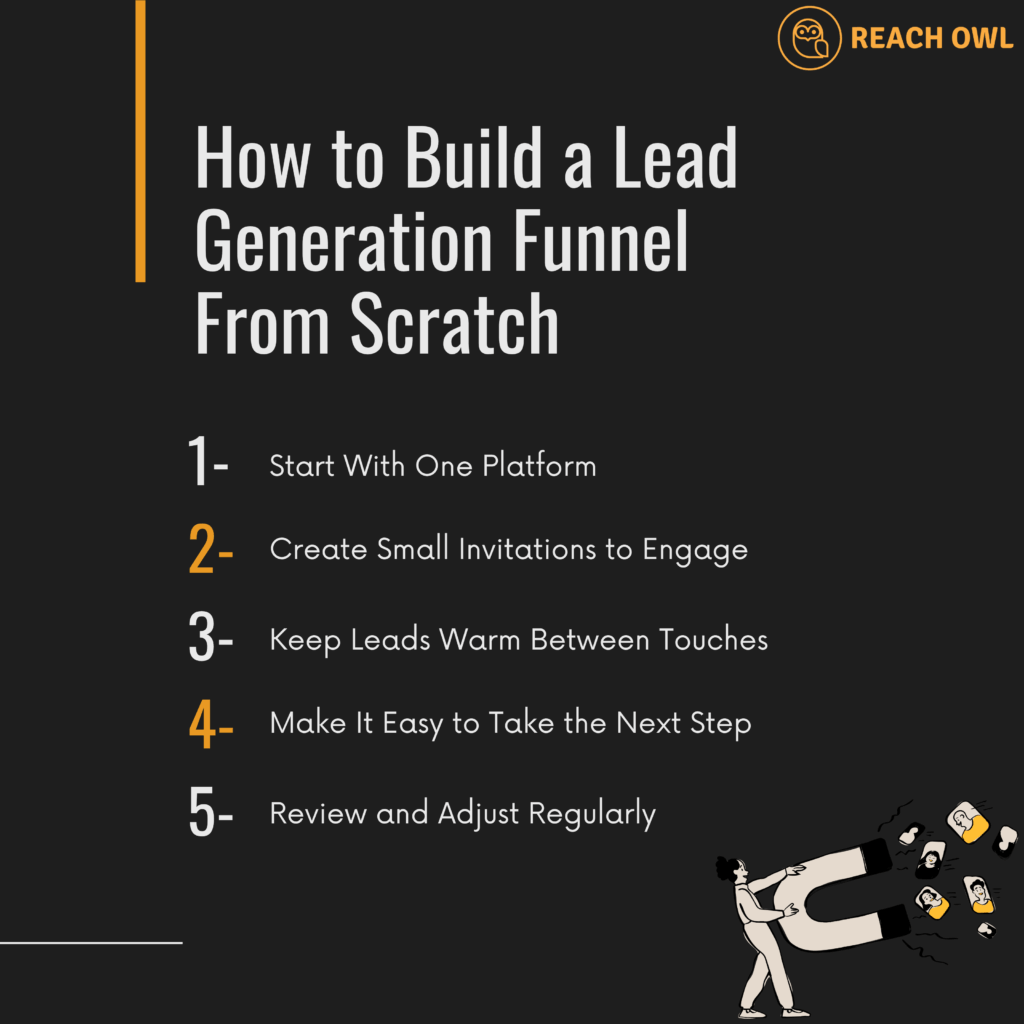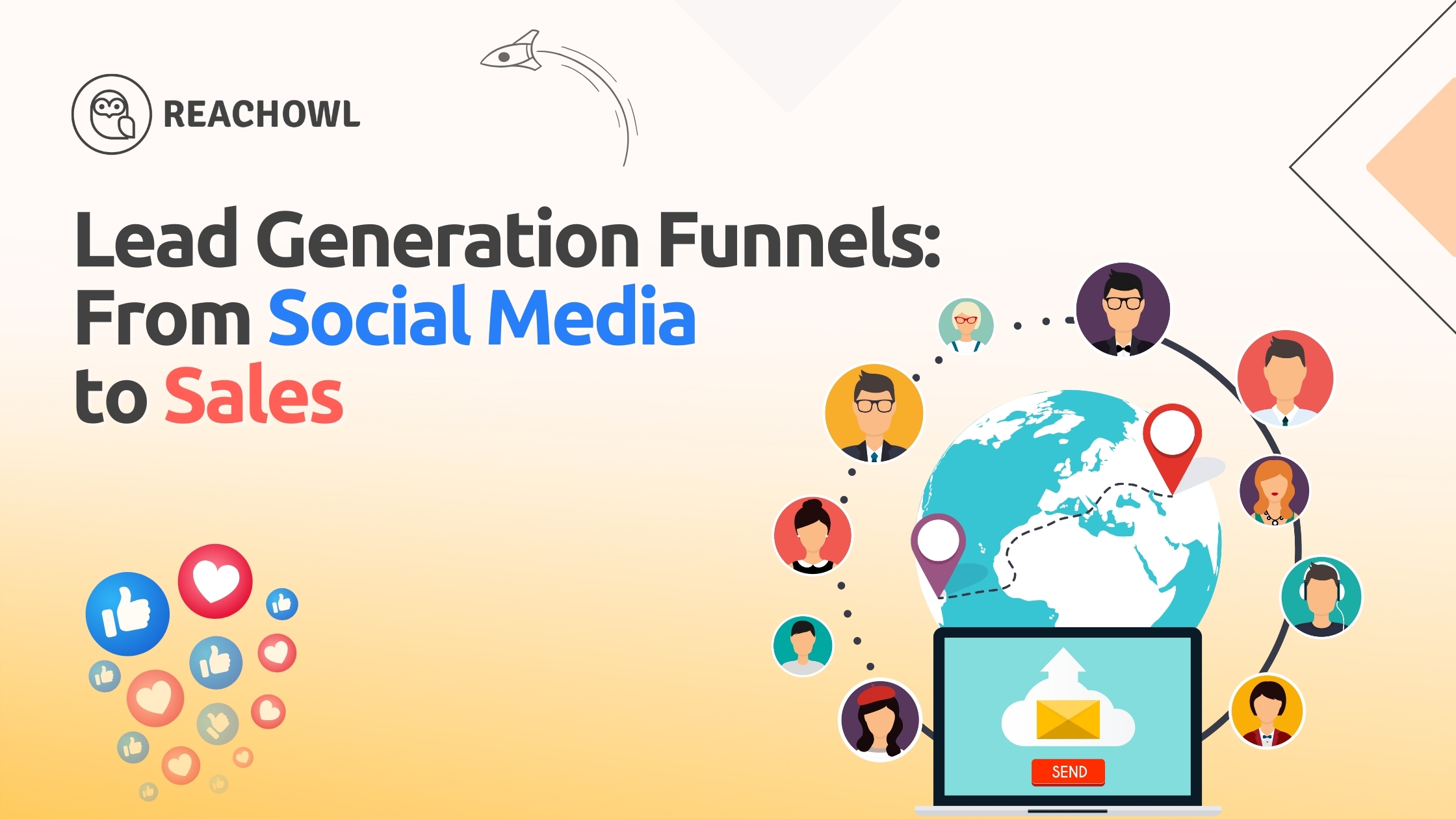You’ve posted every day this month. Stories, reels, carousels. The likes are there. A few shares. Even a handful of DMs.
But sales? Barely moving.
There’s a reason for that. Social media makes it easy to get attention, but turning attention into paying customers takes more than consistent posting. It takes a structured process that moves people from curiosity to commitment—a lead generation funnel.
In this article, we’ll break down how lead generation funnels work on social platforms, why they require a different approach than traditional marketing, and how you can build one that fits the way people engage today.
Understanding Lead Generation Funnels
Think about how people actually decide to buy. It’s rarely instant. Someone scrolls past your post on Instagram, maybe likes it, but then they move on. A few days later, they see another post. They click through, watch a video, and start wondering if what you offer could help them. Weeks later, they finally buy.
That’s a lead generation funnel in real life. It’s not a perfect straight line—it’s a series of small steps where people shift from curious to committed.
The Funnel Stages in Simple Terms

Awareness
You’re scrolling and see a brand post shared by a friend. Maybe it’s a quick reel, or maybe it’s a meme that perfectly fits your day. You don’t click, but you remember the logo. A week later, they show up again. That’s how awareness works on social media: it’s less about a single big splash and more about small, repeated impressions that stick.
Interest
Some people don’t just scroll past the second time. They linger. Maybe they save the post. Maybe they watch two or three more videos without following yet. Or they quietly check your profile at 1 AM. This stage is subtle. You’re not seeing comments or DMs, but signals are there. Now is when consistent posting and helpful content keep them orbiting your brand a little longer each time.
Consideration
Now they’re weighing their options. Maybe they’re browsing reviews or comparing your offer to others. This is where subtle nudges help—retargeting ads, testimonials, or even a quick reply in their DMs can make the difference.
Conversion
Here, the goal is to make saying yes easy. That could mean a direct link in your bio, a one-click checkout, or answering last-minute questions in a private message.
Retention
Many businesses stop after the sale, but social platforms are perfect for keeping customers engaged. Share updates, offer loyalty perks, or check in through DMs. A satisfied customer often brings more people with them.
Why Social Media Funnels Are Different
Traditional funnels rely on email marketing or website visits. Social media is different because interactions occur in real-time. Someone might ask a question in the comments, and others are watching how you respond. A single DM can lead to a sale or a recommendation to their friends.
This is why businesses now use automation tools for DMs and post scheduling. They help keep up with high volumes without losing personal touch. However, even the best tools are most effective when you’re actively engaged.
Unlike static email sequences, a social media funnel is alive. It needs to be flexible as algorithms shift and trends come and go.
The Role of Social Media in Funnel Entry Points
Social platforms aren’t just channels. They’re doorways. Some people step through because of a facebook post. Others because a friend tagged them. And some don’t even follow you yet, but keep ending up on your page.
Instagram works differently from Facebook. On Instagram, you might catch someone’s eye with a reel or a meme. They scroll past. Days later, they see your story. Still no action. It might take five or six touches before they even visit your profile. That’s normal. Funnels don’t start with a single click. They’re made of small, invisible moments that stack up.
Facebook’s flow is softer. A user clicks “Interested” on an event, joins a group to lurk, or downloads a free PDF from a lead ad. They might never like your page, yet they’re in your ecosystem. Many brands miss this because they focus on follower counts, rather than behaviors.
LinkedIn is quieter. People read posts, hover over your profile, and maybe send a connection request weeks later. These aren’t obvious signals, but they’re early steps into the funnel.
Organic and Paid Ways to Pull People In
Some businesses pour everything into ads. It works, but only if your organic content gives people a reason to care.
On Instagram, visuals get you noticed, but comments and DMs build the bridge. Facebook groups are still effective, although you’ll need to participate actively instead of simply dropping links. And LinkedIn? Share insights, not pitches. People can smell self-promotion from a mile away.
Paid campaigns help when organic reach slows. Retargeting is especially useful, as it shows ads to people who have watched a video or saved a post. But if you don’t pair it with organic trust-building, even the best ad won’t stick.
Segmentation Makes Funnels Work
Not every follower is ready to make a purchase. Some just found you. Others have been circling for months. Giving all of them the same content is like handing out umbrellas on a sunny day.
Segmentation helps you show the right thing at the right time. A welcome DM for new followers. A special offer for people who saved a post or clicked through twice.
Tools for automated outreach can make this easier. A simple scheduled message asking “What brought you to our page?” feels personal but runs in the background. Used well, automation doesn’t replace conversations—it starts them.
For anyone doing Facebook marketing, the mix matters. Organic posts, group discussions, Messenger DMs—they all feed the funnel differently. It’s not about forcing people forward. It’s about showing up enough times that moving forward feels natural.
Automate DMs, track leads, and schedule posts with ReachOwl’s all-in-one toolkit.
Mapping the Funnel Journey From Engagement to Sale
A funnel sounds neat on paper, but in practice, it’s messy. People don’t move cleanly from awareness to purchase. They bounce around. One day they like a post. The next week, they forget you exist. Then suddenly they’re replying to a story asking about your pricing.
The journey usually starts with content. A reel, a carousel, even a simple meme. These aren’t sales pitches—they’re ways to stay visible. Think of them as breadcrumbs. Most people won’t click the first time, but each piece of content serves as a reminder that you’re still there.
Then come the conversations. Someone leaves a comment. You reply. Maybe you send a DM to thank them for engaging. These small interactions matter more than most brands realize. Social media funnels don’t feel like funnels to the person moving through them. They feel like a series of friendly nudges.
What Moves People Forward
Once someone starts engaging, the goal is to keep the momentum. Here’s where lead magnets and exclusive offers come into play. A free guide, a discount code, or a limited invite to a webinar, things that reward curiosity and give them a reason to step closer.
For accounts handling a large volume of incoming interest, automated outreach can be beneficial. A scheduled DM that greets new followers or checks in with people who commented last week can keep the conversation alive without feeling robotic. The key is using it to open doors, not replace human responses.
When It’s Time to Ask for the Sale
The mistake most businesses make is rushing this part. Just because someone downloaded a freebie doesn’t mean they’re ready to buy. Look for stronger signals. Maybe they’ve asked a detailed question in a DM or viewed your pricing page twice. That’s when a direct offer makes sense.
On social media, conversions often happen in private. A DM. A quick back-and-forth about features. Then a link to your checkout or calendar. If you’ve done the earlier steps well, this part feels like a natural next step, not a hard sell.
Tools and Automation for Funnel Success
Running a lead generation funnel on social media works fine when you’re small. You can reply to every DM, comment on every post, and keep track of leads in your head. However, once your audience grows, all those manual steps quickly accumulate. That’s when tools and automation become more than a convenience—they’re what keep the funnel from stalling.
Scaling Without Losing the Human Touch
The fear with automation is that people will notice. And they will, if you’re blasting generic messages or setting up workflows that sound like a bot. But done right, automation feels like someone’s just quick at replying.
For example, a welcome message for new followers doesn’t have to be complex. A simple, “Hey, thanks for connecting—what brought you to our page?” opens the door. If they reply, you or your team can jump in to continue the chat.
Tools That Keep Funnels Flowing
There’s no one-size-fits-all toolset, but most brands running active lead funnels use some mix of:
- DM automation tools to send scheduled messages or follow-ups
- CRM platforms to track where each lead is in the funnel
- Social media schedulers for posting consistently without logging in daily
ReachOwl does all three. You can send automated DMs, track every lead with its built-in CRM, and schedule posts without jumping between tools. As your audience grows, it’s a relief to manage everything from one dashboard instead of piecing things together—less chaos, more room for actual conversations.
Automation Isn’t a Replacement
It’s worth saying again—tools don’t close sales, people do. The point of automation isn’t to replace you. It’s there to clear the noise—welcome messages for new followers, a quick reminder about a freebie someone grabbed, tagging people who clicked links. Once a lead starts asking real questions, that’s when you or your team should take over.
Put it this way—automation keeps things running in the background so your team can focus where it matters.
Metrics That Matter in Lead Generation Funnel
Likes and followers feel good, but they’re not the point. The question is, are people moving closer to buying? That’s the real measure of a working lead generation funnel.
You don’t need 20 metrics. Just enough to spot what’s working and where people are dropping out.
Focus on Signals, Not Noise
Initially, it’s about reach. Are people even seeing your posts? If not, that’s a content or algorithm problem.
Once they’re seeing you, look for signals they care—saves, shares, replies, link clicks. These are early signs someone’s paying attention.
But attention isn’t action. To determine if people are taking your content seriously, check your click-through rates. Are they visiting your site, signing up for a freebie, or clicking your bio link? That’s where the funnel tightens.
When they buy, your conversion rate shows how many took the final step. And later, track customer lifetime value—are these buyers sticking around or just one-offs?
Read Between the Numbers
Metrics are only half the story. If people are clicking links but not buying, maybe your landing page isn’t clear. If followers reply to DMs but don’t sign up, maybe your offer came too early.
Look at your data alongside conversations. Social media is full of small signals—questions in comments, reactions to polls—that don’t show up in analytics tools.
Don’t Chase Perfect Numbers
No social media lead funnel converts everyone. If 3% of people who see your posts end up making a purchase, that’s healthy. Funnels aren’t about forcing people through, they’re about spotting who’s ready and helping them take the next step.
Where Lead Funnels Usually Break Down
A lead generation funnel looks clean in a diagram, but real people don’t move like arrows on a chart. They hesitate. They drop off. And most of the time, the breakdown occurs because of small gaps that businesses often overlook.
Trying Too Much Too Soon
It happens a lot. Brands post non-stop, launch ads, and throw in a lead magnet, all at the same time. But if nobody’s noticing your content yet, none of it sticks. The top of the funnel (TOFU) has to catch attention first. Otherwise, the rest just… sits there.
Ignoring the Middle of the Funnel
This is where most lead generation funnels stall. People know you exist. They’ve watched your stories, maybe clicked a link. Most leads here aren’t ready to buy. And they don’t stay warm on their own. This part of the funnel isn’t about pushing—it’s about showing up enough that they don’t forget you. A quick DM reply. A behind-the-scenes story. A nudge to check out that guide they downloaded last week. Small, steady touches work better than a big push.
Treating Every Lead the Same
Not everyone in your funnel wants the same thing. A new follower isn’t at the same point as someone who clicked your pricing page. This is where simple tagging or customer segmentation keeps you from blasting the same offer to everyone.
Forgetting Mobile Users
Most people will see your brand for the first time on their phone. If your landing page takes too long to load or a link in your bio doesn’t work, that’s an instant exit. Check every step on mobile, stories, DMs, forms, even your checkout flow.
Assuming Automation Will Fix It
Automation helps. But it won’t save a funnel if the content isn’t landing or if you’ve gone quiet. When a lead starts asking real questions, a bot isn’t enough. That’s when you or your team need to step in. Automation’s there to handle the repetitive work, not to replace you.
How to Build a Lead Generation Funnel From Scratch

Building a funnel doesn’t have to feel overwhelming. Start small, keep it simple, and focus on one step at a time. Most of the work involves noticing how people move on social media and providing them with gentle nudges to move forward.
1. Start With a Single Platform
Don’t spread yourself thin trying to be everywhere. Select the platform where your audience spends the most time. Instagram, Facebook, LinkedIn—any of them can work as the top of your lead generation funnel. What matters is showing up consistently so people see you enough times to remember your name.
2. Create Small Invitations to Engage
Once people notice you, provide them with ways to interact without feeling pressured. Polls in stories, a short freebie like a checklist, or even a casual DM saying, “Hey, thanks for following—what caught your eye?” These light touches start relationships without feeling like a pitch.
3. Keep Leads Warm Between Touches
This is where most funnels stall. Someone downloaded your guide or replied to a post, and then… silence. Stay visible. Reply quickly to DMs. Post behind-the-scenes content that shows you’re active and approachable. ReachOwl can help here—it sends welcome messages or checks in with people who engaged last week, so nothing slips through the cracks.
4. Make It Easy to Take the Next Step
When someone is ready to buy, don’t make them work for it. Your bio link should load fast. Your checkout page needs to work smoothly on mobile. A DM with a direct link or a story with a swipe-up can save a lead from dropping out. Check every step on your phone, the way a customer would.
5. Review and Adjust Regularly
Funnels aren’t set-and-forget systems. Watch how people move through yours. Are they stopping after clicking your bio link? Are DMs going unanswered? Small tweaks—like clearer CTAs or faster follow-ups, can fix bottlenecks and keep the funnel flowing.
Conclusion
A lead generation funnel isn’t about cramming people into a process. It’s about creating a clear path they actually want to follow, from the first post they see to the moment they buy. On social media, this path isn’t linear. People drop in and out, hesitate, and come back later.
The work is in noticing where they are and giving them the right nudge. A story reply. A follow-up DM. A reminder about the free guide they downloaded last week. Small, steady touches build trust more than any hard pitch.
As you look at your lead funnel, ask yourself—where are people stalling? Which steps feel clunky on mobile? Are your DMs and posts keeping people engaged, or are leads slipping through unnoticed?
Fixing these gaps isn’t about big moves. It’s about refining each part of your social media strategy so that every step feels natural for the person navigating it.
Automate DMs and track leads with ReachOwl.

